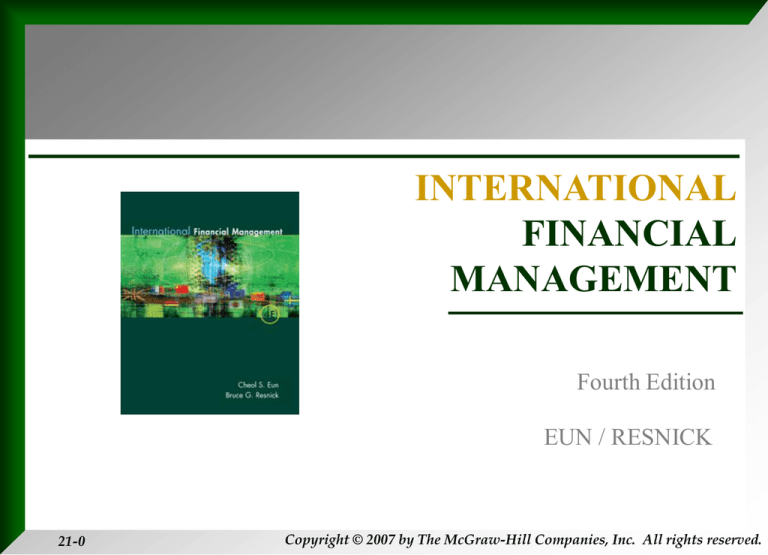
INTERNATIONAL
FINANCIAL
MANAGEMENT
Fourth Edition
EUN / RESNICK
21-0
Copyright © 2007 by The McGraw-Hill Companies, Inc. All rights reserved.
International Tax
Environment
Chapter Objective:
21
Chapter
Twenty-one
INTERNATIONAL
FINANCIAL
MANAGEMENT
This chapter provides a brief introduction to the
international tax environment.
Fourth Edition
EUN / RESNICK
21-1
Copyright © 2007 by The McGraw-Hill Companies, Inc. All rights reserved.
Chapter Outline
The Objectives of Taxation
Tax Neutrality
of Taxation
Types
Equity
Tax
Income
Tax Tax Environments
National
The
Types
of Taxation
Tax
Withholding
Worldwide
Taxation
Structures for Reducing Tax
Organizational
Tax Environments
The
National
Tax
Value-Added
Territorial
Taxation
Liabilities
National
Tax
Environments
TaxSubsidiary
Credits
The
Organizational
Foreign
Branch
and
Structures
Income
for Reducing Tax
Liabilities
Organizational
Payments to and
Structures
from Foreign
forAffiliates
Reducing Tax
Liabilities
Tax Havens
21-2
Controlled Foreign Corporation
Copyright © 2007 by The McGraw-Hill Companies, Inc. All rights reserved.
The Objectives of Taxation
The twin objectives of taxation are:
1. Tax Neutrality
2. Tax Equity
21-3
Copyright © 2007 by The McGraw-Hill Companies, Inc. All rights reserved.
Tax Neutrality
A tax scheme is tax neutral if it meets three criteria:
1.
Capital Export Neutrality: the tax scheme does
not incentivise citizens move their money abroad.
2.
National Neutrality: taxable income is taxed in
the same manner by the taxpayer’s national tax
authorities regardless of where in the world it is earned.
3.
Capital Import Neutrality: the tax burden on a
MNC subsidiary should be the same regardless of where
in the world the MNC in incorporated.
21-4
Copyright © 2007 by The McGraw-Hill Companies, Inc. All rights reserved.
Tax Equity
Tax Equity: regardless of the country in which an
affiliate of a MNC earns taxable income, the same
tax rate and tax due date should apply.
The principal of tax equity is difficult to apply; the
organizational form of the MNC can affect the
timing of the tax liability.
21-5
Copyright © 2007 by The McGraw-Hill Companies, Inc. All rights reserved.
Types of Taxation
Income Tax
Withholding Tax
Value-Added Tax
21-6
Copyright © 2007 by The McGraw-Hill Companies, Inc. All rights reserved.
Income Tax
An income tax is a tax on personal and corporate
income.
Many countries in the world obtain a significant
portion of their tax revenue from income taxes.
An income tax is a direct tax, that is one that is
paid directly by the taxpayer upon whom it is
levied.
21-7
Copyright © 2007 by The McGraw-Hill Companies, Inc. All rights reserved.
50
45
40
35
30
25
20
15
10
5
0
Income Tax Rate
Au
st
Ba ra lia
ha
m
Be a s
lg
iu
m
Br
az
il
Ch
in
Fr a
a
G nce
er
m
an
Ire y
la
nd
Ja
pa
n
M
Un
e
ite xic
d
St o
at
es
Rate
Corporate Income Tax Rates in
Selected Countries
21-8
Copyright © 2007 by The McGraw-Hill Companies, Inc. All rights reserved.
Withholding Tax
Withholding taxes are withheld from the payments
a corporation makes to the taxpayer.
The taxes are levied on passive income earned by
an individual or corporation of one country within
the tax jurisdiction of another country.
Passive income includes dividends and interest
income, income from royalties, patents, or
copyrights.
A withholding tax is an indirect tax.
21-9
Copyright © 2007 by The McGraw-Hill Companies, Inc. All rights reserved.
U.S. Tax Treaty Withholding Rates
Selected Countries
35
30
25
Dividends
Rate
20
Interest
15
Royalties
10
5
Au
st
ra
l
Be ia
rm
ud
a
Be
lg
iu
m
Br
az
il
Ch
in
a
Fr
an
ce
G
er
m
an
y
Ire
la
nd
Ja
pa
n
M
ex
ico
0
21-10
Copyright © 2007 by The McGraw-Hill Companies, Inc. All rights reserved.
Value-Added Tax
A value-added tax is an indirect national tax levied
on the value added in production of a good or
service.
In many European and Latin American countries
the VAT has become a major source of taxation on
private citizens.
Many economists prefer a VAT to an income tax
because the incentive effects of the two taxes
differ sharply.
21-11
Copyright © 2007 by The McGraw-Hill Companies, Inc. All rights reserved.
Value-Added Tax
An income tax has the incentive effect of
discouraging work.
A VAT has the incentive effect of discouraging
consumption (thereby encouraging saving).
VATs are easier to administer as well. While
taxpayers have an incentive to hide their income,
producers have an incentive to make sure that
their upstream suppliers in the production process
declare the value added (and pay the tax!).
21-12
Copyright © 2007 by The McGraw-Hill Companies, Inc. All rights reserved.
Value-Added Tax Calculation
Production
Stage
1
2
3
Selling
Price
Value
Added
Incremental
VAT
€100
€300
€380
€100
€200
€80
€15
€30
€12
Total
VAT
€57
= €100 .15
= €200 .15
= €80 .15
= €380 .15
In this example, the tax rate is 15 percent. Suppose that stage
one is the sale of raw materials to the manufacturer; stage
two is the sale of finished goods to a retailer; stage three is
the sale of inventory from the retailer to the consumer.
21-13
Copyright © 2007 by The McGraw-Hill Companies, Inc. All rights reserved.
Other Types of Taxation
A wealth tax is a tax levied not on income but on
the wealth of a taxpayer. Property taxes are an
example.
A poll tax is a tax on your existence. It is so called
because it was collected from those who wished to
vote.
21-14
Copyright © 2007 by The McGraw-Hill Companies, Inc. All rights reserved.
The National Tax Environments
Worldwide Taxation
Territorial Taxation
Foreign Tax Credits
21-15
Copyright © 2007 by The McGraw-Hill Companies, Inc. All rights reserved.
Worldwide Taxation
Tax national residents of the country on their
worldwide income no matter in which country it
was earned.
21-16
Copyright © 2007 by The McGraw-Hill Companies, Inc. All rights reserved.
Territorial Taxation
Territorial taxation tax residents based upon where
the taxable event occurred.
21-17
Copyright © 2007 by The McGraw-Hill Companies, Inc. All rights reserved.
Foreign Tax Credits
Allows taxpayers to recover somewhat from
double taxation.
Direct foreign tax credits are computed for direct
taxes paid on active foreign-source income of a
foreign branch of a U.S. MNC or on withholding
taxes withheld from passive income.
Indirect foreign tax credits are for income taxes
deemed paid by the subsidiary.
21-18
Copyright © 2007 by The McGraw-Hill Companies, Inc. All rights reserved.
Organizational Structures for
Reducing Tax Liabilities
Branch & Subsidiary Income
Payments to and from Foreign Affiliates
Tax Havens
Controlled Foreign Corporation
Foreign Sales Corporation
21-19
Copyright © 2007 by The McGraw-Hill Companies, Inc. All rights reserved.
Branch & Subsidiary Income
An overseas affiliate of a U.S. MNC can be
organized as a branch or a subsidiary.
A foreign branch is not an independently
incorporated firm separate from the parent.
Branch income passes directly through to the parent’s
income statements.
A foreign subsidiary is an affiliate organization of
the MNC that is independently incorporated.
21-20
Income may not be taxed in the U.S. until it is
repatriated, under certain circumstances.
Copyright © 2007 by The McGraw-Hill Companies, Inc. All rights reserved.
Payments to and from
Foreign Affiliates
Having foreign affiliates offers transfer price tax
arbitrage strategies.
The transfer price is the accounting value assigned
to a good or service as it is transferred from one
affiliate to another.
If one country has high taxes, don’t recognize
income there—have those affiliates pay high
transfer prices. If one country has low taxes,
recognize income there—have those affiliates pay
low transfer prices.
21-21
Copyright © 2007 by The McGraw-Hill Companies, Inc. All rights reserved.
Tax Havens
Tax havens are countries with low corporate
income tax rates and low withholding tax rates on
passive income.
Tax havens were once useful as locations for a
MNC to establish a shell company.
The Tax Reform Act of 1986 greatly diminished
the need for and ability of U.S. corporations to
profit from the use of tax havens.
21-22
Copyright © 2007 by The McGraw-Hill Companies, Inc. All rights reserved.
Controlled Foreign Corporation
The Tax Reform Act of 1986 created a new type
of foreign subsidiary: the controlled foreign
corporation.
A controlled foreign corporation is a foreign
subsidiary that has over half of its voting stock
held by U.S. shareholders—even if these
shareholders are unaffiliated.
21-23
Copyright © 2007 by The McGraw-Hill Companies, Inc. All rights reserved.
Controlled Foreign Corporation
The undistributed income of a minority foreign
subsidiary of a U.S. MNC is tax deferred until it is
remitted via a dividend.
This is not the case with a controlled foreign
corporation—the tax treatment is much less
favorable.
The result is that foreign tax credits are unlikely to
be completely used.
21-24
Copyright © 2007 by The McGraw-Hill Companies, Inc. All rights reserved.
End Chapter Twenty-One
21-25
Copyright © 2007 by The McGraw-Hill Companies, Inc. All rights reserved.






